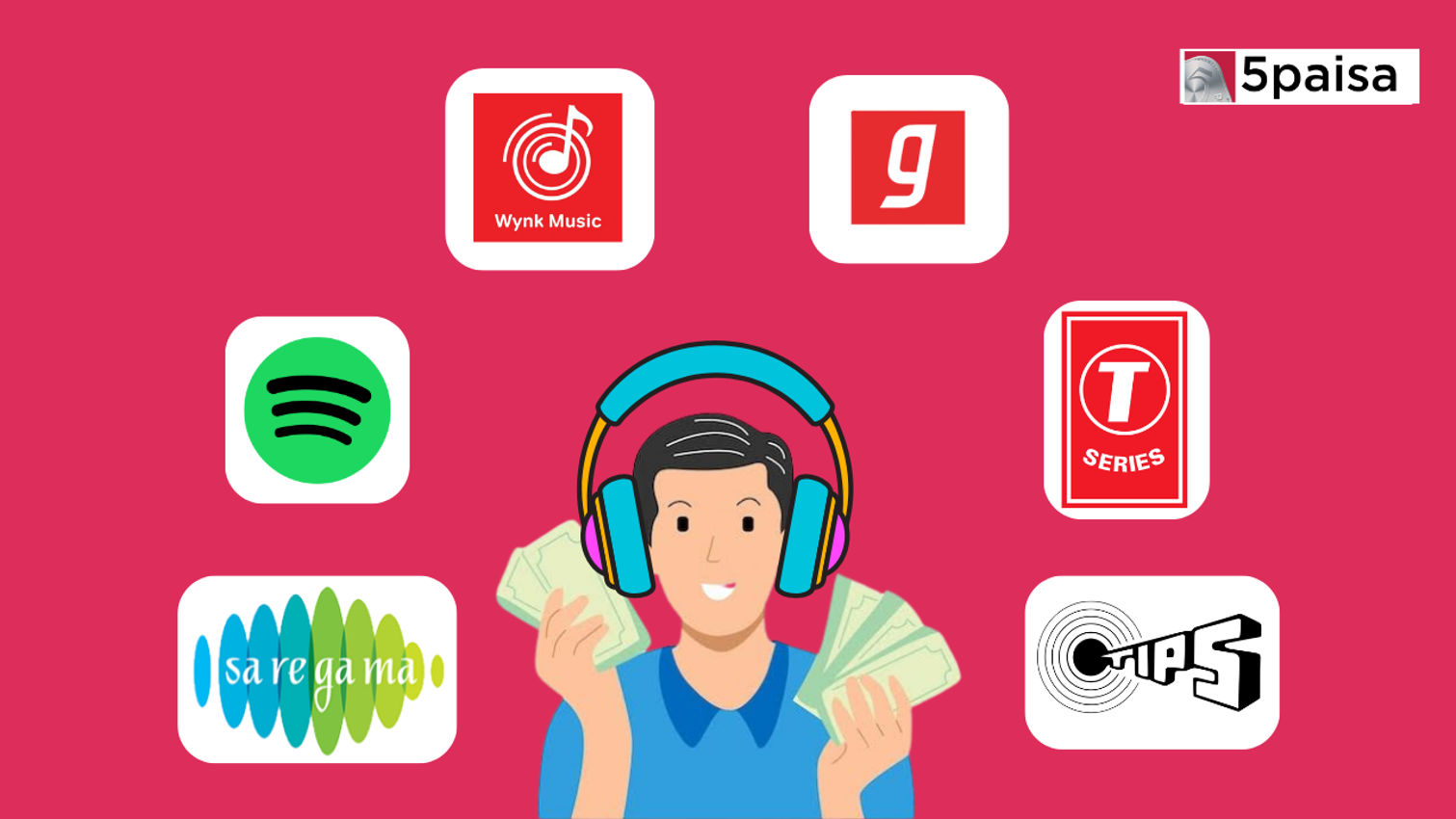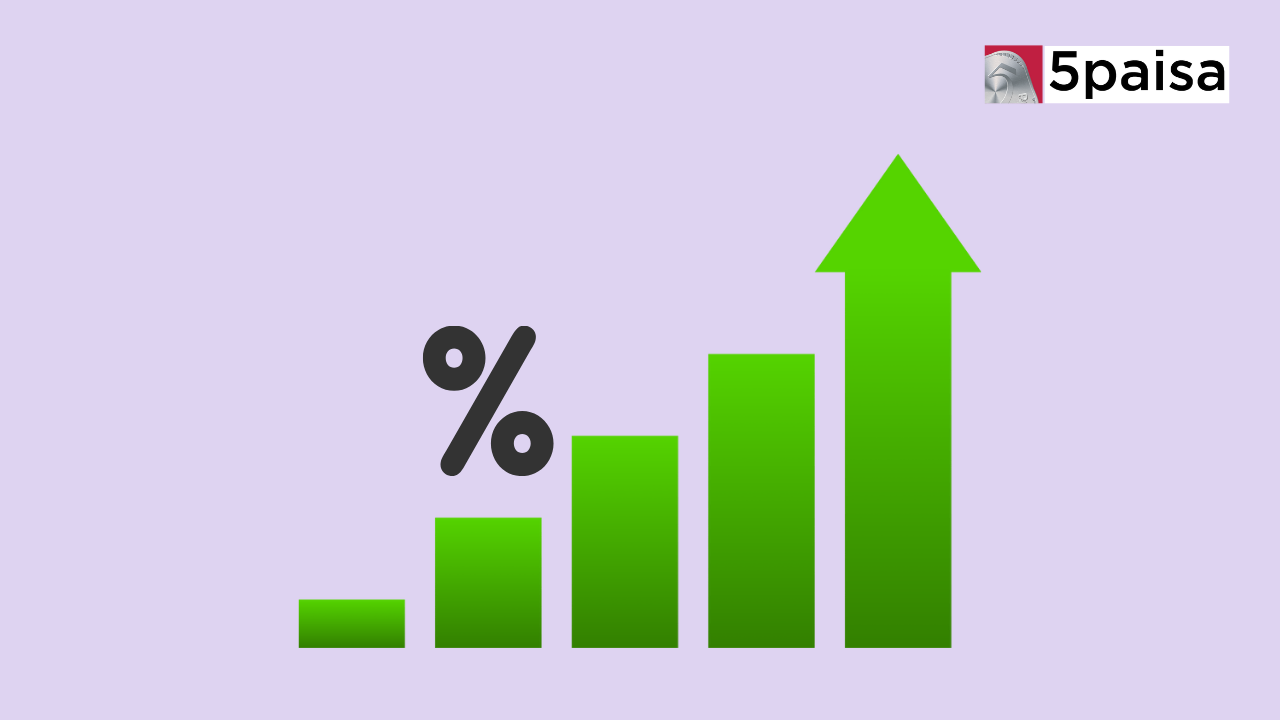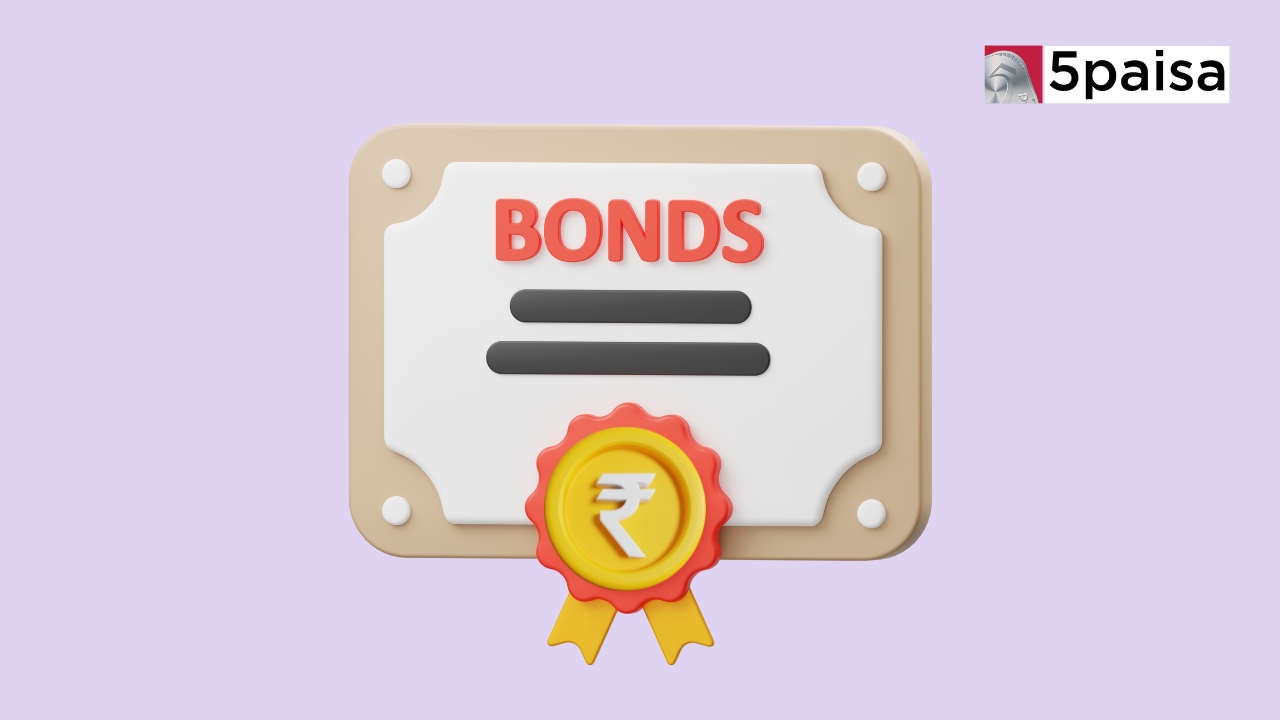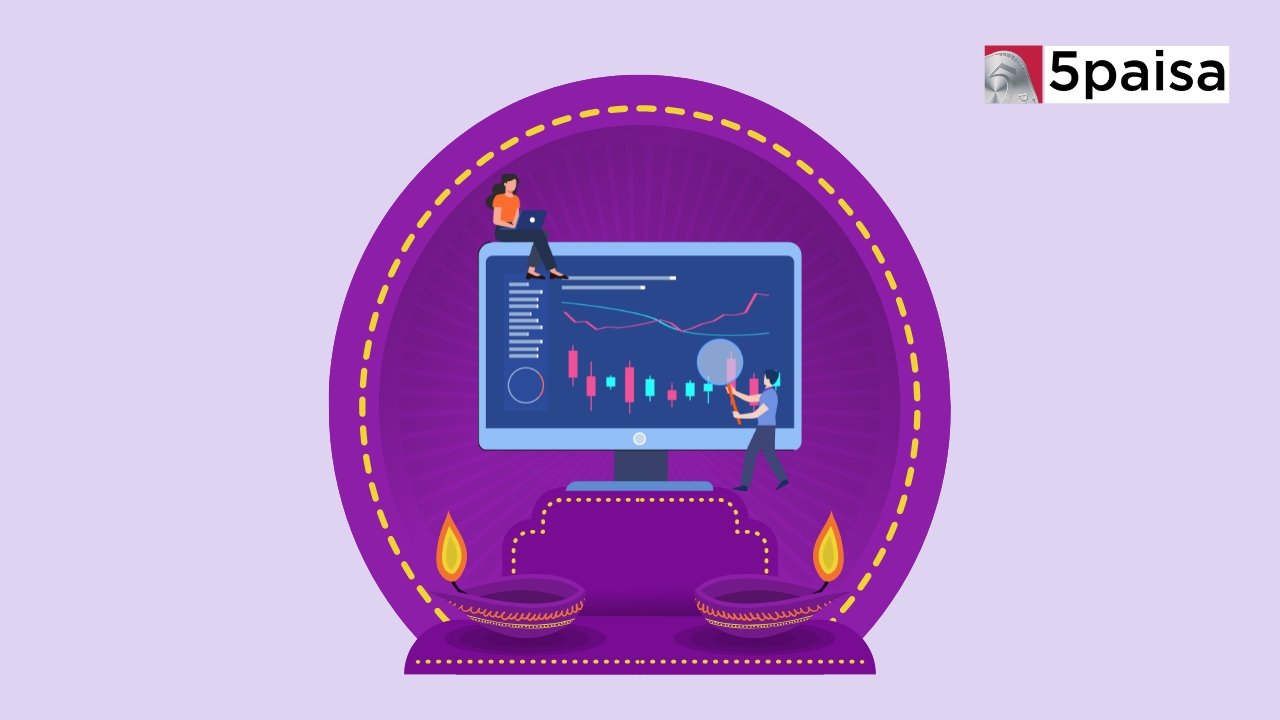ડિસ્કાઉન્ટ પર ટોચના ગ્રોથ સ્ટૉક્સ ટ્રેડિંગ
સંગીત ઉદ્યોગની મની ગેમ

છેલ્લું અપડેટ: 25 ઑક્ટોબર 2023 - 06:19 pm
લતા મંગેશકર દ્વારા એપી ધિલ્લોન પર વાઇબિંગ સુધી "લગ જા ગેલ" સુનવાથી, અમારી સંગીતની પસંદગીઓ વિકસિત થઈ છે. છેલ્લા કેટલાક દશકોમાં, માત્ર અમારી સંગીતની પસંદગીઓ જ વિકસિત નહીં થઈ પરંતુ માધ્યમો કે જેના દ્વારા આપણે સંગીત સાંભળી લીધા છે. જ્યારે કોઈ ઉદ્યોગ આદર્શ બદલાવમાં આવે છે, ત્યારે તમે જોશો છો કે ઉદ્યોગમાં કાર્યરત કંપનીઓનું વ્યવસાયિક મોડેલ, તેમની આવકનો પ્રવાહ પણ બદલવો પડશે. માત્ર એવી કંપનીઓ કે જે આ ફેરફારોને સમૃદ્ધ રાખે છે.
ચાલો સંગીત ઉદ્યોગ, સંગીત ઉદ્યોગની મૂલ્ય સાંકળ અને તેમાં સમૃદ્ધ વ્યવસાયમાં પ્રવેશ કરીએ.
સંગીત ઉદ્યોગની મૂલ્ય સાંકળ
સંગીત મૂલ્ય શૃંખલા એવા લોકો સાથે શરૂ થાય છે જેઓ સંગીત બનાવે છે - ગીત લેખકો, કમ્પોઝર્સ અને ગાયકો. તેઓ ગીતો બનાવે છે અને તેમનાથી પૈસા કમાવે છે. આ ક્રિએટર્સ સંગીતના લેબલ સાથે ટીમ કરે છે, જે તેમને વધુ લોકો સુધી પહોંચવામાં અને સંગીત માટેના તેમના અધિકારોને સુરક્ષિત કરવામાં મદદ કરે છે.
ત્યારબાદ, ફિલ્મના ઉત્પાદકો એવા છે જેઓ ફિલ્મોમાં આ ગીતોનો ઉપયોગ કરે છે. તેઓ સંગીતના લેબલ પર અધિકારો વેચે છે અને ગાયકોને તેમના કાર્ય માટે ચુકવણી કરે છે.
આ ચેઇનનો સૌથી મહત્વપૂર્ણ ભાગ સંગીત લેબલ છે. તેઓ સંગીતનો અધિકાર ધરાવે છે અને તેનો ઉપયોગ વિવિધ પ્લેટફોર્મ્સ પર કરવાની પરવાનગી આપે છે. તેઓ સંગીતમાંથી પણ પૈસા બનાવે છે અને સુનિશ્ચિત કરે છે કે જેમણે સંગીત કર્યું છે તેમને ચૂકવવામાં આવે છે.
છેલ્લે, સ્ટ્રીમિંગ પ્લેટફોર્મ છે. તેઓને સંગીતનો ઉપયોગ કરવાની પરવાનગી મળે છે અને લોકોને તેને ઑનલાઇન સાંભળવાની મંજૂરી આપે છે.
આ ઉદ્યોગમાં પૈસા જોતાં, ચાર મોટા રેકોર્ડ લેબલ્સે 2019 માં સ્પોટિફાઇ પર સાંગીતના લોકોમાંથી 82% બનાવ્યા. આનો અર્થ એ છે કે ઇન્ડસ્ટ્રીને મોટાભાગે કેટલીક કંપનીઓ દ્વારા નિયંત્રિત કરવામાં આવે છે. સંગીતમાંથી કરવામાં આવેલા પૈસાના લગભગ 55% રેકોર્ડ લેબલ પર જાય છે, જ્યારે લગભગ 15-20% સંગીત પ્રકાશકોને જાય છે. આ આપણને વૈશ્વિક સ્તરે સંગીત ઉદ્યોગ કેવી રીતે કાર્ય કરે છે તેનો મોટો ચિત્ર આપે છે.
સંગીતના લેબલ
ચાર રીતો છે જેમાં સંગીતના લેબલ પૈસા બનાવે છે.
1. તેઓ ટીવી ચૅનલો, ઍડ્વર્ટાઇઝર્સ અને ઓટીટી પર ફિક્સ્ડ લાઇસન્સ ફી જારી કરીને કમાઈ શકે છે. ઉદાહરણ તરીકે, સારેગામાએ મેરિકો, બર્ગર, ડાબર, લિમ્કા વગેરેને અને તેના સંગીતનો ઉપયોગ કરવા માટે મોટા દિવસ જેવા નેટફ્લિક્સ પર કાર્યક્રમો માટે લાઇસન્સ જારી કર્યું હતું.
2. ફિક્સ્ડ લાઇસન્સ ફી સોશિયલ મીડિયા પ્લેટફોર્મ્સ જેમ કે ઇન્સ્ટાગ્રામ રીલ્સ, ટિકટોક, ફેસબુક વગેરેને તેના ગીતોનો ઉપયોગ કરવા માટે જારી કરવામાં આવે છે.
3. સંગીત લાઇસન્સિંગ કંપનીઓ પરફોર્મન્સ રાઇટ્સથી પણ રૉયલ્ટી કમાવે છે જેમાં ગાયકો દ્વારા લાઇવ કૉન્સર્ટ્સ અથવા ઇવેન્ટ્સ શામેલ છે.
સ્પોટિફાય, યુટ્યૂબ અને Gaana જેવા સ્ટ્રીમિંગ પ્લેટફોર્મ્સ બે રીતે પૈસા બનાવે છે: મફત યૂઝરો માટે જાહેરાતો દ્વારા અને પ્રીમિયમ યૂઝરો પાસેથી સબ્સ્ક્રિપ્શન ફી.
કેટલાક લોકો માને છે કે સ્ટ્રીમિંગ સર્વિસેજ ગીતોની સંખ્યાના આધારે મ્યુઝિક કંપનીઓને ચૂકવે છે, પરંતુ તે સાચી નથી. તેના બદલે, આ સેવાઓ એક પૂલમાં પૈસા મૂકે છે. સંગીત કંપનીઓને પ્લેટફોર્મ પરના તમામ ગીતોની તુલનામાં તેમના ગીતો કેટલા પ્લે કરવામાં આવે છે તેના આધારે તે પૂલનો એક ભાગ મળે છે.
આ પૂલની સાઇઝ તેના પર આધારિત છે કે સ્ટ્રીમિંગ પ્લેટફોર્મ કેટલા પૈસા બનાવે છે, મોટાભાગે જાહેરાતો અને સબસ્ક્રિપ્શનથી.
સંગીતના લેબલ માટે પૈસા કમાવવાનો આ રીત સારો છે કારણ કે તેઓ વધુ લોકોને તેમના ગીતો સાંભળવાની જરૂર વગર વધુ કમાઈ શકે છે. ઉદાહરણ તરીકે, જો કોઈ મફત વપરાશકર્તા સબ્સ્ક્રિપ્શન માટે ચુકવણી કરવાનું શરૂ કરે છે, તો સંગીતના લેબલ માટે પૈસાનો પૂલ વધે છે, અને તેઓ વધુ પૈસા બનાવે છે, ભલે તે વપરાશકર્તા વધુ સંગીત સાંભળતા નથી. આ ફેરફાર માત્ર તે સંગીતના લેબલ માટે જ નથી જેના વપરાશકર્તા ગીતો સાંભળે છે પરંતુ અન્ય તમામ લેબલ માટે પણ છે, કારણ કે તેઓને હજુ પણ મોટા પૈસા પૂલનો તેમનો હિસ્સો મળે છે.
વૈશ્વિક સ્તરે સંગીત લેબલ ઉદ્યોગ અને ભારતમાં ઝી, સોની સંગીત, ટી-સીરીઝ જેવા કેટલાક ખેલાડીઓ દ્વારા પ્રભાવિત છે.
શા માટે? સંગીત ઉદ્યોગમાં નવું પ્રવેશ કરવું મુશ્કેલ છે.
તમે જુઓ છો, લગભગ 300-400 બૉલીવુડ ફિલ્મો દર વર્ષે સ્ક્રીન પર અસર કરે છે, દરેક પાંચ ગીતો લગભગ આવે છે. તેના પરિણામે બોલીવુડ ઉદ્યોગના લગભગ 15,000-20,000 ગીતો વાર્ષિક ધોરણે જારી થાય છે. જો કોઈ કંપનીનો હેતુ ટી-સીરીઝ જેવા વિશાળ વ્યક્તિને પડકાર આપવાનો છે, જેમાં પહેલેથી જ 26,000 ગીતોનો સંગ્રહ છે, તો તેને આગામી 4-5 વર્ષો માટે નાણાંકીય ખામીઓનો સામનો કરવો પડશે. તે નુકસાનને સતત કર્યા પછી પણ, ટી-સીરીઝની વિશાળ સંગીત લાઇબ્રેરી સાથે મેળ ખાતો સંઘર્ષ કરી શકે છે. તેથી, તુલનાત્મક સંગીત પ્રતિનિધિની સ્થાપનામાં 20-30 વર્ષ સુધીનો સમય લાગી શકે છે.
મ્યુઝિક સ્ટ્રીમિંગ ઇન્ડસ્ટ્રી
છેલ્લા ત્રણ વર્ષોમાં, સંગીત ઉદ્યોગે નાણાંકીય વર્ષ 23 માં 460 મિલિયન નાટકો સુધી પહોંચીને સમયના ગીતોની સંખ્યામાં મોટી વૃદ્ધિ જોઈ છે, જે પહેલાં કરતાં 1.6 ગણી વધુ છે.
તાજેતરમાં, સ્થાનિક ભાષાઓમાં, ખાસ કરીને તેલુગુ ગીત "નાટુ નાટુ" ની સફળતા પછી, ગોલ્ડન ગ્લોબ અવૉર્ડ્સ અને ઑસ્કર્સ પર જીતવા પર, સ્થાનિક ભાષાઓમાં સંગીત બનાવવામાં ઘણું રસ છે. આ વલણ માત્ર શરૂઆત કરી રહ્યું છે અને લોકપ્રિય બની રહ્યું છે. ઑનલાઇન સંગીતના સંદર્ભમાં, સ્થાનિક ભાષાઓમાં ગીતો પાછલા ત્રણ વર્ષોમાં, ખાસ કરીને નાના શહેરોમાં, વધુ ડિજિટલ ઉપયોગ અને સ્થાનિક સંગીતના લેબલ સાથેની ભાગીદારીને કારણે સૌથી ઝડપી વિકસિત થયા છે. નાણાંકીય વર્ષ 23 માં રમવામાં આવેલા તમામ સંગીતના 34 ટકા માટે લોકલ મ્યુઝિકનું એકાઉન્ટ.
આઇ-ફિક્કી અહેવાલ મુજબ, 200+ મિલિયન ભારતીયો દ્વારા ખર્ચ કરવામાં આવેલા સમયના 83% જે સંગીત પ્લેટફોર્મનો ઉપયોગ કરે છે તે ભારતીય સંગીત પર છે, જે 49% ના વૈશ્વિક સરેરાશ કરતાં વધુ છે. પ્રાદેશિક સંગીતનો હિસ્સો પણ દેશમાં કુલ સંગીત સ્ટ્રીમિંગના લગભગ 40% સુધી વધી ગયો છે.
રેડસીર દ્વારા એક રિપોર્ટમાં ઉલ્લેખ કરવામાં આવ્યો છે કે સ્પોટિફાય છેલ્લા ત્રણ વર્ષોમાં એક શ્રેષ્ઠ સંગીત અનુભવ પ્રદાન કરવા અને એક મજબૂત બ્રાન્ડ બનવા માટે ખૂબ જ લોકપ્રિય બની ગયો છે. તેણે નાણાંકીય વર્ષ 23 માં તમામ સંગીતના નાટકોમાં 26 ટકા કૅપ્ચર કર્યું છે. આ પ્લેટફોર્મ 15 અને 30 વર્ષની વચ્ચેના યુવા વપરાશકર્તાઓને આકર્ષિત કરવામાં સફળ રહ્યું છે, જે સંગીત પ્રસારણમાં નવા વપરાશકર્તાઓને લાવવામાં મુખ્ય ભૂમિકા ભજવે છે.
માત્ર આંતરરાષ્ટ્રીય સંગીત જ નહીં, વધુ હિન્દી અને સ્થાનિક ભાષાના ગીતો ઉમેરવા પર ધ્યાન કેન્દ્રિત કરો, તેને સમગ્ર ભારતમાં વિવિધ ઉંમરના જૂથોમાંથી વધુ વપરાશકર્તાઓ મેળવવામાં મદદ કરી છે. આ તેની વૃદ્ધિ અને સફળતાને સ્પોટિફાઇ કરવામાં ફાળો આપ્યો છે, જે તેને બજારમાં એક મુખ્ય ખેલાડી બનાવે છે.
સ્પોટિફાઇ માટે ગેમ ચેન્જરની વ્યૂહરચના તેના પૉડકાસ્ટ રહી છે.
એક વસ્તુ જે અન્ય મ્યુઝિક એપ્સથી સ્પોટિફાઇ કરી શકે છે તે તેના અનન્ય અને વિશેષ પૉડકાસ્ટ છે. આ પૉડકાસ્ટ માત્ર સ્પોટિફાઇ પર જ ઉપલબ્ધ છે, જેનો અર્થ એ છે કે તમે તેમને અન્ય કોઈપણ સ્થળે શોધી શકતા નથી. આ લોકોને અન્ય એપ્સ પર સ્પોટિફાઇ પસંદ કરવાની સંભાવના વધુ બનાવે છે. જો રોગન અનુભવને પોડકાસ્ટ કરવાનો અધિકાર રાખવા માટે કેવી રીતે મોટા $200 મિલિયનની ચુકવણી કરવી તે આનું સારું ઉદાહરણ છે. આ દર્શાવે છે કે આ વિશિષ્ટ પૉડકાસ્ટ કેટલા મહત્વપૂર્ણ છે.
તેઓએ તેમના પોતાના પૉડકાસ્ટ બનાવવા માટે રણવીર અલ્લાહબાડિયા અને લીઝા મંગલદાસ જેવા નિર્માતાઓ સાથે પણ જોડાયા છે. આજે, સ્પોટિફાઇના મ્યુઝિક શ્રોતાઓનો એક ત્રિમાસ પણ પૉડકાસ્ટમાં જોડાઈ રહ્યા છે.
“ભારતમાં પૉડકાસ્ટિંગ ખૂબ સારી રીતે પિક-અપ કરી રહ્યું છે, કારણ કે વધુ ભારત પર ધ્યાન કેન્દ્રિત કન્ટેન્ટ બનાવવામાં આવે છે, અને જન ઝેડ અને મિલેનિયલ્સ સાંભળવાની આદતો અપનાવે છે. આપણે જે અન્ય વલણ પસંદ કરી રહ્યા છીએ તે ઑડિયો સીરીઝ માર્કેટ છે, જે સૌથી ઝડપી વિકસતા સેગમેન્ટમાંથી એક છે," રેડસીરમાં સીનિયર એન્ગેજમેન્ટ મેનેજર મુકેશ કુમારે જણાવ્યું હતું
ભારતની આત્માઓને મનમોહક બનાવનાર મેલોડીની જેમ, સંગીત ક્ષેત્રના ટોચના કૂતરાઓ સતત તેમની વ્યૂહરચનાઓને અનુકૂળ બનાવે છે. તે એક થ્રિલિંગ સંગીત ક્વેસ્ટ સમાન છે, અને સ્પૉટલાઇટ સ્પોટિફાઇ પર છે. શું સંગીત સ્ટ્રીમિંગ ડોમેનના વિવાદિત શાસક બનવાનું વધશે? આ મનોરંજક વર્ણનના અધ્યાયો આપણી સંગીત મુસાફરીના ભવિષ્યની ચાવી ધરાવે છે.
5paisa પર ટ્રેન્ડિંગ
તમારા માટે શું મહત્વપૂર્ણ છે તે વધુ જાણો.
ભારતીય સ્ટૉક માર્કેટ સંબંધિત લેખ
ડિસ્ક્લેમર: સિક્યોરિટીઝ માર્કેટમાં રોકાણ બજારના જોખમોને આધિન છે, રોકાણ કરતા પહેલાં તમામ સંબંધિત દસ્તાવેજો કાળજીપૂર્વક વાંચો. વિગતવાર ડિસ્ક્લેમર માટે કૃપા કરીને ક્લિક કરો અહીં.
 5Paisa રિસર્ચ ટીમ
5Paisa રિસર્ચ ટીમ સચિન ગુપ્તા
સચિન ગુપ્તા




